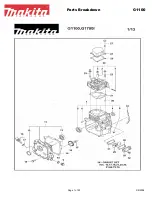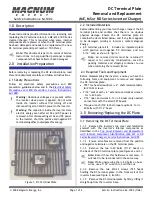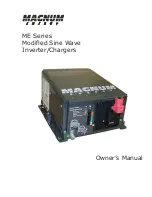6.0
TROUBLESHOOTING GUIDE
6.1
OVERVIEW
The 2GXM module has several LED indicators available to assist in the determination of problems. Refer
to Section 3.5, Verify Operation, for LED definitions.
6.1.1
Power Issues
Problem:
The Power LED does not illuminate after installation is complete or no LED indicators are ON
Possible Causes:
A. For standalone modules, confirm that the power supply is connected to both the module and the AC or
DC power source. If Power LED is still not illuminated, use a voltmeter and check the voltage of the power
source (AC/DC converter used with the standalone unit should measure between 9 -15 VDC no load at the
barrel connector).
B. For plug-in module, confirm that the chassis is connected to an AC or DC power source. If the Power
LED is still not illuminated, remove the module and verify the operation of other modules in the chassis. If
power is present and the module will not turn ON, replace the module.
C. The plug-in module requires ~ 7.0 watts (3.3VDC @ 2.1 amps) for normal operation. The AC Power
Supply in a 19-Module Chassis can supply ~ 60 watts (3.3VDC @ 18amp). A fully loaded 19-Module
chassis of 2GXM modules will require two power supplies for standard operation. This condition will
cause the power LED not to illuminate.
6.1.2
Fiber Issues
Problem:
The Fiber Optic link LED does not illuminate after installation is complete.
Possible Causes:
A. Verify the Link Mode selection is set to Link Segment (LS). Until a stable link is established, leave the
Link Mode configured for LS. After a Link presence is established, the Link Mode selection can be modified.
B. Confirm that the fiber optic cable is properly connected to the
iConverter
2GXM
and the remote fiber
optic device. Connecting the fiber between the Tx of the far end to the Rx on the near end will cause the P1
LED on the near end to illuminate (only when the link mode is configured for Link Segment). Completing
the connection will cause the far end P1 LED to illuminate.
C. Confirm that the fiber cable type matches the fiber transceiver type (multimode, single-mode) on the
iConverter
2GXM.
D. If using a dual-fiber model, confirm that the transmitter (Tx) is attached to the receiver side of its link
partner, and that the receiver (Rx) is attached to the transmitter. A optical power meter will assist in
determining which cable should be connected to the Tx and Rx of the module. To insure proper operation,
a minimum of -17dBm to - 28dBm must be present at the fiber optic receiver.
E. If using a single-fiber model, confirm that the Tx wavelength on the
iConverter
2GXM matches the Rx
of the connected fiber optic device. Single-fiber units transmit and receive at different wavelengths (1510nm/
1310nm). Verify the model numbers to insure proper compatibility.
NOTE:
If corrective actions do not resolve your situation, please contact Omnitron Systems Technical
Support.
Page 43


















